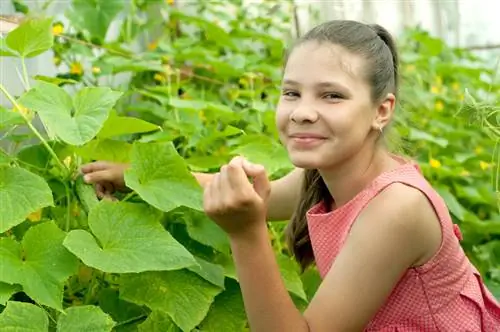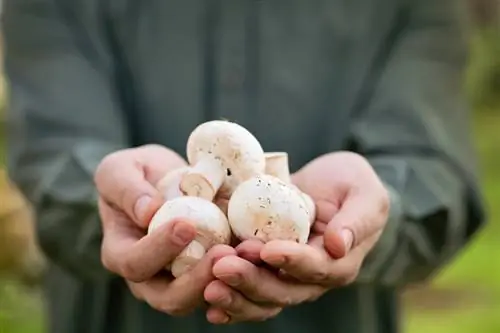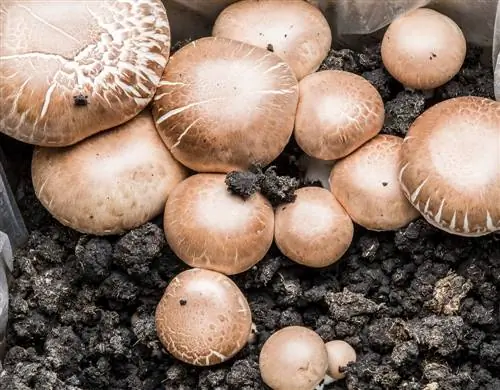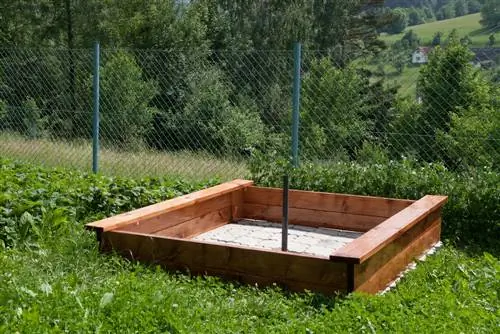- Author admin [email protected].
- Public 2023-12-16 16:46.
- Last modified 2025-01-23 11:19.
Many mushroom pickers swear by secret places where you can find tasty edible mushrooms year after year. As a mushroom lover, you can be more comfortable if you simply grow certain types of mushrooms yourself.

How can I grow mushrooms myself?
In order to successfully grow mushrooms yourself, you need the right substrate, mushroom spores and optimal environmental conditions. Mushrooms and lime mushrooms grow well on straw bales or coconut substrate in the dark basement, while oyster and lime mushrooms thrive on dead wood in foil greenhouses.
The special features of mushroom growth
Mushrooms are not botanically classified as plants because their growth differs relatively greatly from plants. After all, fungi have no chlorophyll, which means they cannot carry out photosynthesis themselves. Rather, many species of fungi obtain their required growth energy from the decomposition processes of wood and other plant materials. The visible fruiting bodies of the mushrooms above the earth's surface represent only the tips of the mushrooms, with which they can spread further into the landscape via spores.
The mycelium as the “root” of the mushrooms
The main part of most known mushroom species is the so-called mycelium, a root-like network in the substrate. This not only provides energy for the growth of the visible fruiting bodies, but can also be used to spread through the soil without spores. The largest known honey fungus in North America covers an area of several square kilometers, making it one of the largest living creatures on Earth.
Understanding mushroom growth for successful cultivation
They can only be cultivated successfully with an understanding of the basic factors of mushroom growth. Many mushrooms place much higher demands on the location and environment than on bushes and trees. Mycorrhizal fungi such as porcini mushrooms that live in symbiosis have so far been difficult to grow because they rely on living together with the roots of certain tree species. Since each mushroom species has very specific requirements for its habitat, these factors must be specifically created by humans for mushroom cultivation.
Mushroom varieties for cultivation
Only certain types of mushrooms are suitable for cultivation. Others, on the other hand, are still almost exclusively harvested in nature for the food trade. This also includes seasonally strongly represented species such as:
- Chanterelles
- Porcini mushrooms
- Oyster mushrooms
Other varieties, however, can be grown even by beginners with controlled temperature and humidity values using the right substrate and fungal spores.
Prepare the substrate
Lime mushrooms and champignons can be grown well in a dark basement on straw bales or on coconut substrate. To do this, the straw is first dipped in water and then inoculated with fungal spores from specialist retailers. For mushrooms, it takes about two to three weeks for the mushroom mycelium to grow well through the entire substrate. The formation of the desired fruiting bodies can then take place within a few days and, like the entire growth phase, does not require any light. To ensure that regular watering of the growing substrate does not cause problems, a cellar or shed that can tolerate high humidity over a long period of time should be chosen for cultivation.
Cultivation on dead wood
Some types of edible mushrooms grow particularly well on dead wood because they decompose it and use the energy released for their own growth. Oyster and lime mushrooms belong to this category of mushrooms, which can cover a small dead tree trunk after a few weeks of care. Specialist retailers have pieces of wood available (€8.00 on Amazon) that have already been inoculated with the corresponding spores. But you can also purchase spores in the shape of sticks, which you sink into the drill holes of your own dead wood trunks. In order to ensure a warm and humid climate as easily as possible, small foil greenhouses are suitable as protection over the oyster and lime mushroom cultures. These also prevent foreign fungal spores from the air from colonizing the respective subsurface.
Tips & Tricks
Growing edible mushrooms requires different levels of skill in producing certain environmental factors depending on the type of mushroom selected. Beginners should first grab mushrooms in a prepared culture box. It just needs to be watered regularly to ensure the tasty mushroom caps grow. This means that the same mushroom box can be harvested two to three times in a row without further care until the energy from the growing substrate has been used up.






